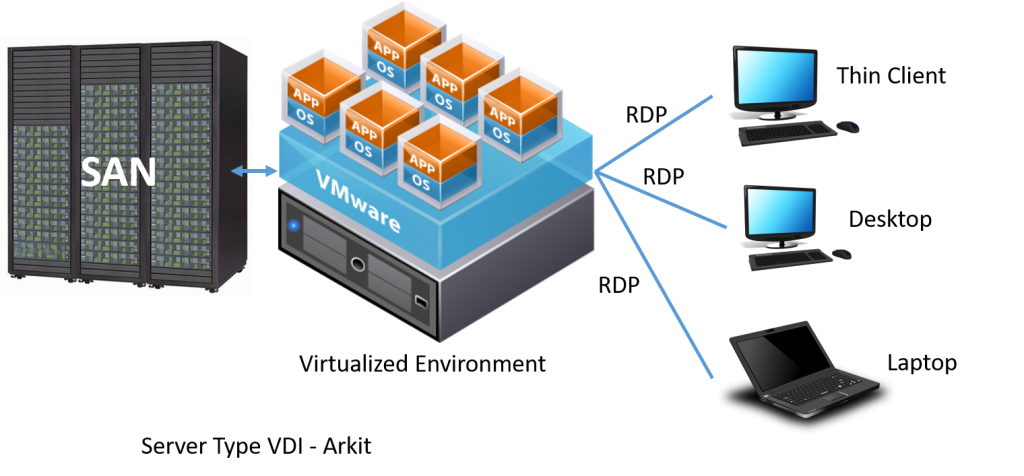VDI Virtual Desktop Infrastructure A Robust Environment
VDI = Virtual Desktop Infrastructure is a computing model that incorporates a layer of virtualization between a control server and desktop PCs. With VDI, a user’s desktop is hosted virtually and lives in a data center server. This allows users to access their desktop from any place and on any device. Plus, network administrators are provided with a streamlined and less frustrating computing experience. There are many virtual desktop infrastructure services available for installation and implementation.
What is Virtual Desktop Infrastructure
The Underlying architecture of a PC is the same as that of industry standard server consisting of hardware an Operating system and applications in exactly the same way that a server be virtualized so can a Personal Computer. The Operating system and software applications can be encapsulated into a file which in conjunction with a hypervisor piece of specilized software can emulate the original system but physically run on any compatible hardware this is most often within a server in the same way number of virtual servers can be hosted on physical server.
Number of virtual desktop PC’s can be hosted on a physical server to virtual desktops can be moved from one host server to another. Providing benefits in terms of load balancing and resilience of the infrastructure. The Virtual machine continues to operate regardless of this move. Virtual Desktops have data requirements same as servers do meaning network or shared storage is the only practical option in an environment where these systems may move from one host to another host.
So now we have a solution in which PC’s have been virtualized and resided within a pool of servers virtual desktops can be moved from server to server, reasons of load balancing or resilience they can be deployed in minutes instead of hours. They consume less power. Centrally Managed and have extra protection of backups. Administered by IT because all data is now within the network storage.
What is the catch, clue is the personal impersonal computer its whole purpose is to interact with human beings a real PC interacts through devices such as mouse keyboard screen and a host of peripherals like webcams, scanners, printers Etc. Now PC is virtual and sitting as a software image on a server away in the data center or cloud. In Order for virtual PC’s to be useful we a way of simulating these interactions remotely.
Virtual PC need to connect to a device local to the user which has the following components
- Screen (Monitor)
- Keyboard
- Mouse
- USB Connector to connect other devices
- Network Connectivity
User computer shouldn’t be very powerful from a computing perspective because what we are doing is providing a window into virtual PC which is actually running on a server this is achieved using either a web browser or simple client application which runs on the device this kind of combination of back-end systems coupled with local client devices is called virtual desktop infrastructure.
Types of VDI
As shown in picture above it’s an costly infrastructure ever, because SAN is more, Servers are Costly and Thin Clients are also costly. Servers are configured with clustered environment because in case of host fail (Hardware Fail) another host with in cluster will take care of all the deployed virtual desktop machines.
Here each user will have on Virtual machine and they will access there allocated virtual machine using RDP protocol from thin client/client machine. So each and every user virtual machine and there data stored in appropriate VM. If you want to update/patch you have to patch all of the VM’s one by one.
Client type Virtual Desktop Infrastructure is quite different then Server type VDI. Here you can use virtualized infrastructure but you are not going to deploy so many VM’s. We have single Golden Image every one access the same with there user profile, whatever they want to save it will saved in file.
Any update does not required to do for all users, just do it in Golden Image it will be applicable for all users in single go. Application installation and management going to be very easy and infrastructure cost going to decrease 75% less.
VDI – Virtual Desktop Infrastructure Free Books Download
- 10 Ways to Save with Desktop Virtualization
- Desktop Virtualization A Cost Effective First Step
- The Essential V.D.I Guide
- Windows 2012 Hyper-V Installation and Configuration Guide – V.D.I
- Seven Reasons to Deploy Tintri For V.D.I
Conclusion:
Instead of using multiple high end configuration desktop machines, deploy all the desktop machines in Data center and access using any devices such as Thin Client, Mobile Device, Tablet Device and Desktop Machine. Using this VDI technology Virtual Desktop Infrastructure will provide most secured environment, Backup user data in case of disaster and Centralized Management. Reduce Infrastructure cost comparatively 75% less. Small & Medium business can also benefit if you use Client Side Virtualization.
Related Articles
PXE Boot Server Configuration RHEL 7
How to Install and Configure KVM in RHEL 7
Setup your Own Linux Lab at Home
Thanks for your wonderful Support and Encouragement
- Get Email | Download E-Books
- Facebook Page
- Youtube Channel
- Exclusive Telegram Group
- Discuss On WhatsApp Group









Great…!!
Nicely explain aa well…